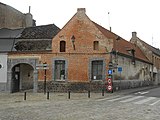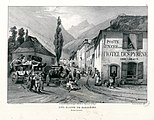
A post office is a public facility and a retailer that provides mail services, such as accepting letters and parcels, providing post office boxes, and selling postage stamps, packaging, and stationery. Post offices may offer additional services, which vary by country. These include providing and accepting government forms, and processing government services and fees. The chief administrator of a post office is called a postmaster.

The Pony Express was an American express mail service that used relays of horse-mounted riders between Missouri and California. It was operated by the Central Overland California and Pikes Peak Express Company.
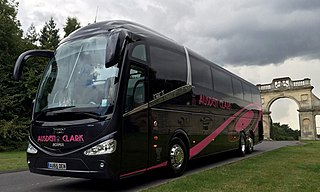
A coach is a type of bus built for longer-distance service, in contrast to transit buses that are typically used within a single metropolitan region. Often used for touring, intercity, and international bus service, coaches are also used for private charter for various purposes. Coaches are also related and fall under a specific category/type of RVs.

A stagecoach is a four-wheeled public transport coach used to carry paying passengers and light packages on journeys long enough to need a change of horses. It is strongly sprung and generally drawn by four horses although some versions are drawn by six horses.
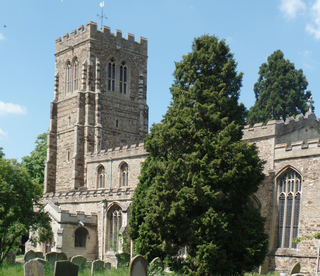
Eaton Socon is a community in the civil parish of St Neots, in the Huntingdonshire district, in the county of Cambridgeshire, England. Eaton Socon is a component of the town of St Neots, located on its south-west margin. Eaton Socon lies on the west side of the River Great Ouse, and is bounded on the west by the A1 road and on the south by the A428 road. On the north side Duloe Brook delineates the boundary with Eaton Ford, which is also part of St Neots.

Cobb & Co was the name used by many successful sometimes quite independent Australian coaching businesses. The first was established in 1853 by American Freeman Cobb and his partners. The name Cobb & Co grew to great prominence in the late 19th century, when it was carried by many stagecoaches carrying passengers and mail to various Australian goldfields, and later to many regional and remote areas of the Australian outback. The same name was used in New Zealand and Freeman Cobb used it in South Africa.
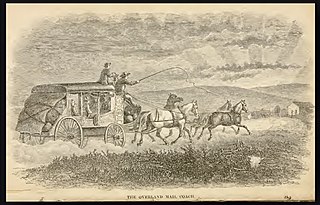
Butterfield Overland Mail was a stagecoach service in the United States operating from 1858 to 1861. It carried passengers and U.S. Mail from two eastern termini, Memphis, Tennessee, and St. Louis, Missouri, to San Francisco, California. The routes from each eastern terminus met at Fort Smith, Arkansas, and then continued through Indian Territory (Oklahoma), Texas, New Mexico, Arizona, Mexico, and California ending in San Francisco. On March 3, 1857, Congress authorized the U.S. postmaster general, at that time Aaron V. Brown, to contract for delivery of the U.S. mail from St. Louis to San Francisco. Prior to this, U.S. Mail bound for the Far West had been delivered by the San Antonio and San Diego Mail Line since June 1857.

The coaching inn was a vital part of Europe's inland transport infrastructure until the development of the railway, providing a resting point (layover) for people and horses. The inn served the needs of travellers, for food, drink, and rest. The attached stables, staffed by hostlers, cared for the horses, including changing a tired team for a fresh one. Coaching inns were used by private travellers in their coaches, the public riding stagecoaches between one town and another, and the mail coach. Just as with roadhouses in other countries, although many survive, and some still offer overnight accommodation, in general coaching inns have lost their original function and now operate as ordinary pubs.

An intercity bus service or intercity coach service, also called a long-distance, express, over-the-road, commercial, long-haul, or highway bus or coach service, is a public transport service using coaches to carry passengers significant distances between different cities, towns, or other populated areas. Unlike a transit bus service, which has frequent stops throughout a city or town, an intercity bus service generally has a single stop at one location in or near a city, and travels long distances without stopping at all. Intercity bus services may be operated by government agencies or private industry, for profit and not for profit. Intercity coach travel can serve areas or countries with no train services, or may be set up to compete with trains by providing a more flexible or cheaper alternative.
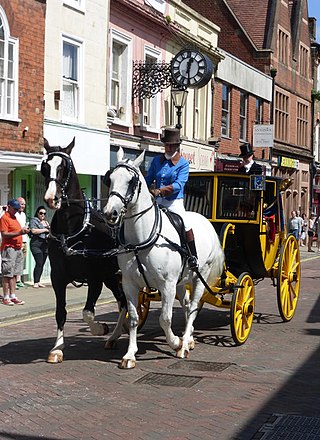
A post-chaise is a fast carriage for traveling post built in the 18th and early 19th centuries. It usually had a closed body on four wheels, sat two to four persons, and was drawn by two or four horses.

A horse-drawn vehicle is a piece of equipment pulled by one or more horses. These vehicles typically have two or four wheels and were used to carry passengers or a load. They were once common worldwide, but they have mostly been replaced by automobiles and other forms of self-propelled transport but are still in use today.

A postilion or postillion is a person who guides a horse-drawn coach or post chaise while mounted on the horse or one of a pair of horses. By contrast, a coachman controls the horses from the vehicle itself.

Post riders or postriders describes a horse and rider postal delivery system that existed at various times and various places throughout history. The term is usually reserved for instances where a network of regularly scheduled service was provided under some degree of central management by the State or State licensed monopoly.
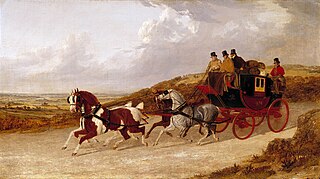
A mail coach is a stagecoach that is used to deliver mail. In Great Britain, Ireland, and Australia, they were built to a General Post Office-approved design operated by an independent contractor to carry long-distance mail for the Post Office. Mail was held in a box at the rear where the only Royal Mail employee, an armed guard, stood. Passengers were taken at a premium fare. There was seating for four passengers inside and more outside with the driver. The guard's seat could not be shared. This distribution system began in Britain in 1784. In Ireland the same service began in 1789, and in Australia it began in 1828.
Cobb & Co is the name of a company that operated a fleet of stagecoaches in Australia in the late 19th century. Cobb & Co itself did not operate in New Zealand officially but its name was used by many private stage coach operators.

A coach is a large, closed, four-wheeled, passenger-carrying vehicle or carriage usually drawn by two or more horses controlled by a coachman, a postilion, or both. A coach has doors in its sides and a front and a back seat inside. The driver has a raised seat in front of the carriage to allow better vision. It is often called a box, box seat, or coach box. There are many of types of coaches depending on the vehicle's purpose.

A roadhouse or stopping house (Canada) is a small mixed-use premises typically built on or near a major road in a sparsely populated area or an isolated desert region that serves passing travellers, providing food, drinks, accommodation, fuel, and parking spaces to the guests and their vehicles. The premises generally consist of just a single dwelling, permanently occupied by a nuclear family, usually between two and five family members.

Stage wagons are light horse-drawn or mule-drawn public passenger vehicles often referred to as stagecoaches. Like stagecoaches they made long scheduled trips using stage stations or posts where the horses would be replaced by fresh horses. Stage wagons were intended for use in particularly difficult conditions where standard stagecoaches would be too big and too heavy.

The Keighley and Kendal Turnpike was a road built in 1753 by a turnpike trust between Keighley in the West Riding of Yorkshire and Kendal in Westmorland, England. The primary instigators were in Settle. The road followed a modified ancient route through Craven. It necessitated bridge widening, reorientation in some of the towns it passed and the relocation of inns and stables. The road was of great benefit to commerce in the northwest but proved a financial loss as the cost of repairing wear caused by heavy traffic was underestimated. The trust's records were lost when it closed.

A post house, posthouse, or posting house was a house or inn where horses were kept and could be rented or changed out. Postriders could also be hired to take travellers by carriage or coach and delivered mail and packages on a route, meeting up at various places according to a schedule. Routes included post roads. A postmaster was an individual from whom horses and/or riders known as postilions or "post-boys" who might help a coachman drive coaches could be hired. A postilion might also travel on a coach to take back his employer's horses. The postmaster would reside in the post house.










